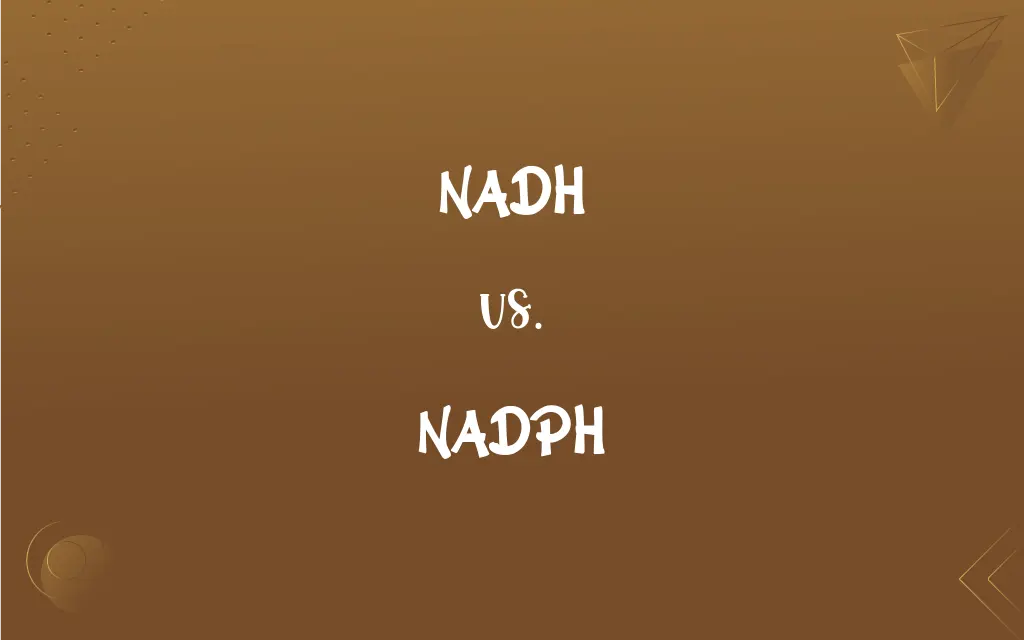NADH vs. NADPH: What's the Difference?
Edited by Aimie Carlson || By Harlon Moss || Updated on October 27, 2023
NADH is a coenzyme involved in cellular respiration and energy production; NADPH is crucial for biosynthesis and antioxidant defense.

Key Differences
NADH stands for nicotinamide adenine dinucleotide (NAD) + hydrogen (H). It plays a pivotal role in cellular respiration, particularly in the electron transport chain where it donates electrons.
NADPH, which stands for nicotinamide adenine dinucleotide phosphate (NADP) + hydrogen (H), is vital in biosynthetic reactions, such as fatty acid and nucleotide synthesis. It also has a key role in antioxidant defense.
Both NADH and NADPH are forms of the coenzyme NAD. NADH is predominantly involved in catabolic reactions, where it acts as an electron carrier and helps in generating ATP.
NADPH, on the other hand, is primarily involved in anabolic reactions. It provides the reducing power needed for the synthesis of biomolecules.
Despite their similarities, NADH and NADPH have different roles. NADH is central to energy production, while NADPH is crucial for building and maintaining cells and protecting them from oxidative damage.
ADVERTISEMENT
Comparison Chart
Full Name
Nicotinamide Adenine Dinucleotide + Hydrogen
Nicotinamide Adenine Dinucleotide Phosphate + Hydrogen
Main Function
Electron carrier in energy production
Provides reducing power for biosynthesis
Role in Metabolism
Involved in catabolic reactions
Involved in anabolic reactions
Location in Cells
Mitochondria (in eukaryotes)
Cytoplasm
Electron Donor For
Electron transport chain
Biosynthetic reactions, antioxidant defense
ADVERTISEMENT
NADH and NADPH Definitions
NADH
NADH is crucial for ATP synthesis.
Cellular energy production relies heavily on NADH.
NADPH
NADPH stores energy in chemical bonds.
NADPH stores energy for anabolic reactions.
NADH
NADH carries electrons in cellular respiration.
NADH donates electrons to the electron transport chain.
NADPH
NADPH helps in detoxifying reactive oxygen species.
NADPH is crucial in the regeneration of glutathione.
NADH
NADH is involved in metabolism.
Various metabolic pathways generate NADH.
NADPH
NADPH is essential for synthesizing fatty acids and nucleotides.
NADPH provides reducing power for biosynthesis.
NADH
NADH participates in redox reactions.
NADH gets oxidized during the production of ATP.
NADPH
NADPH participates in reduction reactions.
NADPH is reduced during fatty acid synthesis.
NADH
NADH plays a role in breaking down glucose.
NADH is a byproduct of glycolysis and the Krebs cycle.
NADPH
NADPH is produced in the light reactions of photosynthesis.
In plants, NADPH is generated in the chloroplasts.
NADH
The reduced form of NAD.
NADPH
The reduced form of NADP.
FAQs
What does NADH stand for?
NADH stands for Nicotinamide Adenine Dinucleotide + Hydrogen.
What is the primary role of NADPH?
NADPH provides reducing power for biosynthesis and antioxidant defense.
Does NADPH participate in anabolic or catabolic processes?
NADPH participates in anabolic processes.
Where is NADH mainly found in cells?
NADH is mainly found in mitochondria in eukaryotic cells.
Is NADPH involved in energy production?
NADPH is not directly involved in ATP synthesis but provides energy for biosynthetic reactions.
How is NADH produced?
NADH is produced in glycolysis, the Krebs cycle, and other metabolic pathways.
Where does NADPH function in cells?
NADPH functions in the cytoplasm.
What happens to NADH during cellular respiration?
During cellular respiration, NADH is oxidized to NAD+ in the electron transport chain.
Are NADH and NADPH interchangeable in metabolic processes?
No, NADH and NADPH are not interchangeable; they have specific roles in different metabolic processes.
What does NADPH stand for?
NADPH stands for Nicotinamide Adenine Dinucleotide Phosphate + Hydrogen.
What is the main function of NADH?
The main function of NADH is to carry electrons for ATP production.
Is NADH involved in anabolic or catabolic reactions?
NADH is involved in catabolic reactions.
How is NADPH generated?
NADPH is generated in the pentose phosphate pathway and in photosynthesis in plants.
Does NADH play a role in antioxidant defense?
NADH is not directly involved in antioxidant defense; that's more the role of NADPH.
Can NADPH be used in the electron transport chain?
NADPH is not used in the electron transport chain; that's the role of NADH.
Is NADH found in chloroplasts?
NADH is not typically found in chloroplasts; it's mainly in mitochondria.
What is the importance of NADPH in photosynthesis?
In photosynthesis, NADPH provides reducing power for the synthesis of glucose.
Can NADH be used for biosynthesis?
NADH is primarily used in energy production, not biosynthesis.
Is NADPH involved in detoxifying cells?
Yes, NADPH plays a crucial role in detoxifying cells by maintaining antioxidant systems.
Can NADH be converted to NADPH?
NADH and NADPH are not directly interconvertible; they serve different functions.
About Author
Written by
Harlon MossHarlon is a seasoned quality moderator and accomplished content writer for Difference Wiki. An alumnus of the prestigious University of California, he earned his degree in Computer Science. Leveraging his academic background, Harlon brings a meticulous and informed perspective to his work, ensuring content accuracy and excellence.
Edited by
Aimie CarlsonAimie Carlson, holding a master's degree in English literature, is a fervent English language enthusiast. She lends her writing talents to Difference Wiki, a prominent website that specializes in comparisons, offering readers insightful analyses that both captivate and inform.































































